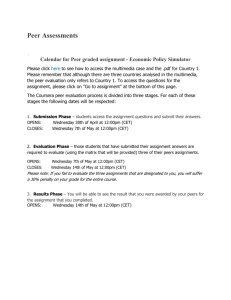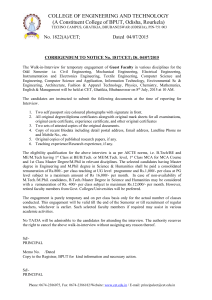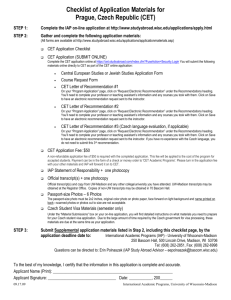Minutes from 12/16 Meeting - William S. Hackett Middle School
advertisement
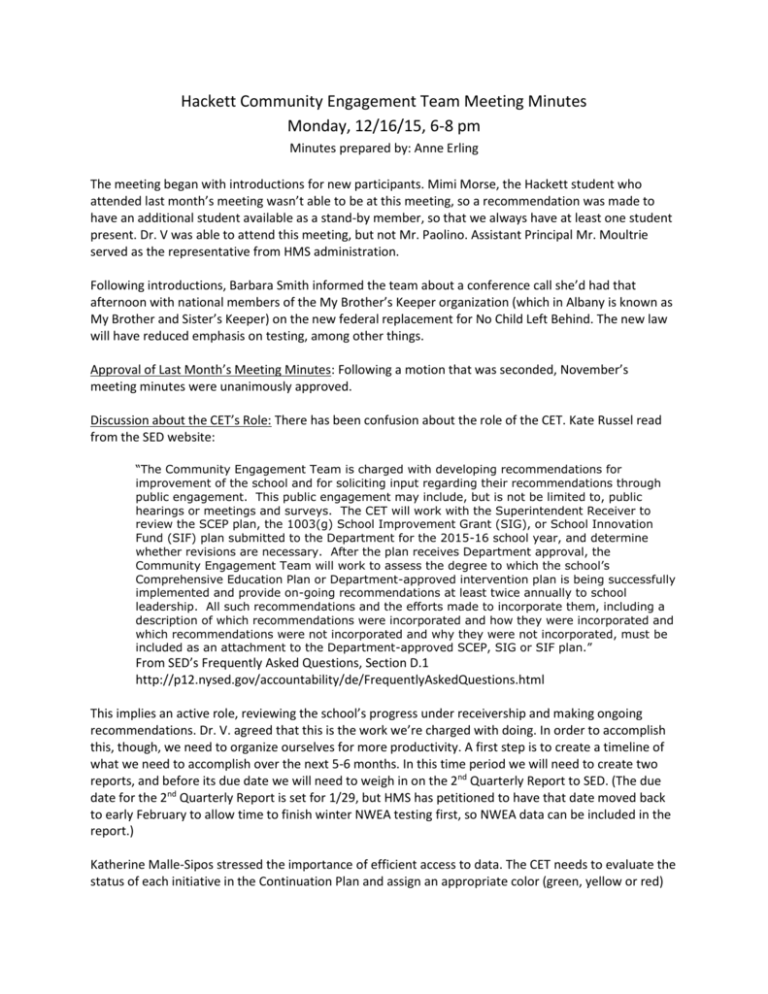
Hackett Community Engagement Team Meeting Minutes Monday, 12/16/15, 6-8 pm Minutes prepared by: Anne Erling The meeting began with introductions for new participants. Mimi Morse, the Hackett student who attended last month’s meeting wasn’t able to be at this meeting, so a recommendation was made to have an additional student available as a stand-by member, so that we always have at least one student present. Dr. V was able to attend this meeting, but not Mr. Paolino. Assistant Principal Mr. Moultrie served as the representative from HMS administration. Following introductions, Barbara Smith informed the team about a conference call she’d had that afternoon with national members of the My Brother’s Keeper organization (which in Albany is known as My Brother and Sister’s Keeper) on the new federal replacement for No Child Left Behind. The new law will have reduced emphasis on testing, among other things. Approval of Last Month’s Meeting Minutes: Following a motion that was seconded, November’s meeting minutes were unanimously approved. Discussion about the CET’s Role: There has been confusion about the role of the CET. Kate Russel read from the SED website: “The Community Engagement Team is charged with developing recommendations for improvement of the school and for soliciting input regarding their recommendations through public engagement. This public engagement may include, but is not be limited to, public hearings or meetings and surveys. The CET will work with the Superintendent Receiver to review the SCEP plan, the 1003(g) School Improvement Grant (SIG), or School Innovation Fund (SIF) plan submitted to the Department for the 2015-16 school year, and determine whether revisions are necessary. After the plan receives Department approval, the Community Engagement Team will work to assess the degree to which the school’s Comprehensive Education Plan or Department-approved intervention plan is being successfully implemented and provide on-going recommendations at least twice annually to school leadership. All such recommendations and the efforts made to incorporate them, including a description of which recommendations were incorporated and how they were incorporated and which recommendations were not incorporated and why they were not incorporated, must be included as an attachment to the Department-approved SCEP, SIG or SIF plan.” From SED’s Frequently Asked Questions, Section D.1 http://p12.nysed.gov/accountability/de/FrequentlyAskedQuestions.html This implies an active role, reviewing the school’s progress under receivership and making ongoing recommendations. Dr. V. agreed that this is the work we’re charged with doing. In order to accomplish this, though, we need to organize ourselves for more productivity. A first step is to create a timeline of what we need to accomplish over the next 5-6 months. In this time period we will need to create two reports, and before its due date we will need to weigh in on the 2nd Quarterly Report to SED. (The due date for the 2nd Quarterly Report is set for 1/29, but HMS has petitioned to have that date moved back to early February to allow time to finish winter NWEA testing first, so NWEA data can be included in the report.) Katherine Malle-Sipos stressed the importance of efficient access to data. The CET needs to evaluate the status of each initiative in the Continuation Plan and assign an appropriate color (green, yellow or red) identifying levels of success at addressing each initiative, but to do that we need data. These determinations can’t be based on personal opinion. At the same time, we need to be mindful of the time needed by school staff to produce this data and make sure our requests relate to our monitoring role vis a vis the Continuation Plan. We have a range of opinions on what we should focus on in our monitoring role. One option is to focus on the language of the Continuation Plan recommendations – not the indicators per se – determining whether the school is moving from red to green on implementing each recommendation, not on whether student data is improving. A contrasting view is that we need to ready ourselves to make recommendations for next year. Keeping an eye on student indicators will help us determine the level of success a particular initiative is having in moving the dial at Hackett – which will help us make appropriate recommendations for next year. Probably we should keep our eyes on both. Review of the Status of the 10 items on the Continuation Plan (CP) that were coded as yellow or red in the 1st Quarterly Report: 1. CP Strategy #3 - Partnership with local colleges and universities to provide more intensive 1:1 academic tutoring for identified students. HMS will provide additional literacy and math tutors for the after-school extended day program: The CET asks if it’s happening, and how many tutoring sessions have been held with how many students and how many tutors. If it isn’t happening, we ask what the timeline is for implementing it. Also, it would be good to know that there’s an evaluative tool being used, and we’d like to see evaluative data on the sessions. 2. CP Strategy #4 - Ensure full curriculum in all core academic subjects: We requested the curricular status of each Hackett course – core and non-core classes -- in our November meeting. We would like to see a chart that, for each course at Hackett, identifies if that course’s curriculum is fully developed, developing, or undeveloped, as well as whether that curriculum has been rolled out in Hackett’s classrooms such that SED would give that course a passing grade for curriculum development in their walk-through this year. 3. CP Strategy #9 - Develop and implement the Albany Peace Project’s Mindful Moments (APPMM) program at HMS: In response to a question of whether it’s happened, we learned that the contract was approved, teachers had their first PD on the topic, and mindful moments will start school-wide in January. 4. CP Strategy #11 - Partnership with In Our Own Voices (IOOV): The CET would like to know if this partnership has begun. Dr. V. will check. 5. CP Strategy #12 – Development of Comprehensive Parent/Family Engagement Plan: Anne reminded the group that the language for this strategy in the First Quarterly Report inaccurately identifies this receivership year strategy as that of developing a plan. In fact, in HMS’s SED approved Continuation Plan, our goal this year isn’t just to develop a plan, but to implement the various steps identified in that strategy. That language needs to be corrected in the remaining quarterly reports for this year. The CET would like to know the status of the various steps in that plan. Has any progress been made towards surveying parents as described in the plan? What is the status of the development of informational materials as described in the plan to help parents understand what their student should be learning in each class, and how to monitor how well their student is meeting those standards? What is the status of preparing job specifications for the planned new community outreach workers, and recruiting for and hiring these individuals? What is the status of work to build partnerships with community organizations to maximize the impact of this community outreach effort? What about the 6. 7. 8. 9. 10. planned trainings for parents in ELA and math standards? The Fall math and literacy night did some of this. Are any other events in the planning stage, and any efforts being made to make this information available to parents unable to attend the events? Dr. V. invited and collected names of CET members interested in joining a work group to focus on this strategy. She will contact interested individuals to set up a time to meet. CP Strategy #15 – Purchase Compass Learning to provide weekly progress monitoring of all students receiving AIS interventions: This was purchased this week and trainings are happening later this week. CP Strategy #17 – HMS will continue to expand the use of technology by providing electronic access to textbooks and other online resources: What progress has been made on this? Does HMS have money budgeted for this? CP Strategy #18 – HMS Community Engagement Team will explore the concept of instituting a full-service Community School Model: Has there been any concrete movement on studying implementation of a community school model? There’s a need for a team to develop this. HMS is in the process of trying to locate a person to lead this work. Tomorrow there is a meeting with the SUNY Dean of Social Welfare and Provost for Community Engagement. There also have been conversations with County Executive Dan McCoy. Once the new SIG hire is onsite, that person will be able to focus on this and help move it forward. Also, Chris (last name?), a meeting attendee this evening, is engaged in doing research related to full service in community schools. She invited us to be involved in efforts to establish a map of Albany that identifies community resources in each neighborhood. We can contribute by helping identify resources in our own neighborhoods, within a particular radius distance from our home. Chris will talk with Barry about this GIS work she’s doing as a start to getting others involved in populating the map with resources in their neighborhoods. CP Strategy #19 – HMS will provide intense daily small group (2-5 students per group) instruction in ELA for students currently at Level 1 on the NYS ELA assessment: Is this happening? How many students have been identified for this? A teacher member commented that groups of 2-5 are too small – that they can’t meet all needy students with groups that small. Hackett is servicing more students by refining its Tier breakdowns to ensure they target those students who really need services. The Community Engagement Team: It’s appropriate to keep the status of this initiative coded yellow since we still struggle with establishing a membership that’s reflective of the Hackett community as a whole. We also don’t have a concrete plan for completing our required public reports and community outreach. We haven’t charged anyone to be our public spokesperson. There are two additional lines coded as Yellow in the first Quarterly Report. These deal with the school’s progress in meeting its selected indicators, and since Mr. Paolino isn’t at this meeting, we can’t get clarity on these issues. We will want to get an update on how well we’re meeting these indicators before the second quarterly report is prepared. Additional requests for information to Dr. V and HMS staff from CET members: 1. Katherine Malle-Sipos asked for answers to questions asked formally at last meetings. Dr. V provided an answer to one of them: The additional money provided administrators in this year’s contract was provided as one time stipends, not increases to base salaries. 2. Katherine also requested an update on plans presented at the press conference at Hackett in early November with community leaders. At our November meeting Mr. Paolino didn’t have any information on whether anything was developing in that area. 3. Connie Centrello asked that the CET be provided a budget narrative for this year’s Continuation Plan budget that provides a timeline for expected budget expenditures, and asked that we receive such a narrative when we receive next year’s budget spreadsheet. 4. Dahlia Herring recommended that the CET receive a presentation at an upcoming meeting from someone related to HMS’s full service center. Ray Gifford was recommended. 5. Sam Shipherd mentioned the surveys filled out at the Open School days and the Math and Literacy night and asked that the CET be given a report on survey responses. 6. CET members requested current figures for the indicators HMS selected for the Continuation Plan. Ideally, we would like to see the NWEA data presented as a comparison chart showing NWEA scores for Spring of the prior year, and then Fall, Winter and Spring of this year. Samuel Carrera mentioned that other schools in receivership monitor student learning every 6 weeks, not only every 3 months as we do with NWEA testing. Ideally we should have a more regular way to see if students are moving forward as needed. 7. We requested information about the Friday afternoon professional development for teachers, the extent to which topics are aligned with improvement goals for teachers, and whether Mr. Paolino recommends specific PD topics. In response, Deb Calvo-McNicholas gave the group a primer on Friday PD sessions. Mr. Paolino has incorporated looking for evidence of WICOR (Writing to Learn, Inquiry, Collaboration, Organization, and Reading to Learn – the five guiding principles in the Advancement Via Individual Determination program that Hackett has just initiated this year for a select group of 7th graders, with the broad concepts being disseminated to all teachers throughout the building) in his regular building class walk-throughs, and has a form where he records what he sees. Friday PD topics arise out of deficiencies in what he sees in these walk-throughs. For example, he wasn’t seeing a high enough percentage of classes using the kind of reading strategies recommended in AVID, so the Friday PD was used to teach teachers how to use close reading strategies in their classes. They had teachers practice using the strategies, then translate those strategies to content they’re using in their classrooms. The goal is that Mr. Paolino will see a consequent increase in the percentage of classrooms demonstrating use of these close reading strategies in his next walk-throughs. A CET member asked whether all PD is tied to the AVID program. PD’s goal is to teach effective learning strategies, and the AVID program has effective strategies that are being shared with all teachers. Other than this, though, AVID is not a building-wide initiative. It’s a specific program open to a small number of students who elect to join the program. In this first year it’s open only to a classroom sized group of seventh graders. A CET member asked if any PD targets classroom/behavior management. Not directly, to date. There is a school behavior strategist who rotates through team meetings every day and helps teachers develop plans for their specific challenges. Beyond this, when teachers apply successful strategies in their classrooms, the material ceases to be inaccessible to students, which cuts down on behavior problems. We asked for responses to all outstanding questions before our next meeting, so that we will be prepared to weigh in on establishing an appropriate status (red, yellow, or green) for each strategy and indicator in the next Quarterly Report. Discussion of how we might move forward on CET issues so that we can move our own CET status from Yellow to Green: Piggybacking on school events to disseminate information on the CET: We need to communicate our work to the wider community. Deb Calvo-McNicholas mentioned that as the AVID site coordinator she also is charged with publicizing that program and has made use of other events at the school to do so. We can make use of the ENL parent night on 1/21 or 1/27 (date not fully set, but there will be translators there, so it will provide a great opportunity for us to get word out to people who don’t speak English), Open School Week in February and the World Culture Night in March to staff a table to provide information about the CET’s work. There was general agreement in the CET that we should get on the schedules for these events and identify one or a number of volunteers to attend and share information about the CET with attendees. Preparing a “cheat sheet” that describes the work of the CET and invites participation: To do this effectively, we should prepare a document that describes the CET. Susan D’Entrement volunteered to draft a one page “cheat sheet” that describes the CET, what it does, and invites people to get involved. Anne Erling will also help. The goal will be to complete a draft by 1/10, send it to CET members for comments, and by 1/13, send it to the District to be translated in time to be available for the ENL event at the end of January. Project management planning for CET deliverables: Ford McClain volunteered to prepare a project management tool that we can use to keep track of the specific tasks we need to accomplish, along with point people and target dates for each task. He will meet with Barry Walston to put this together. Preparation of required CET reports: One thing that we need to include on our timeline is the tasks associated with preparing at least two reports on our work, since the SED receivership law charges us with this requirement. Dr. V will seek clarification from SED on why the CET needs to prepare these reports when Dr. V is already submitting quarterly reports. Kate mentioned that our reports might be intended to have a broader scope than the quarterly reports – rather than just commenting on indicators and strategies, perhaps we are to add a broader perspective on the work. Assuming that we do need to prepare these reports, Anne suggested that we make use of a couple of meetings to address issues in a manner appropriate for these reports, and use the minutes of those meetings to serve as our official reports. Dahlia added that we may need to revise the format of the minutes to make them appropriate for such a report. Use report card mailing to disseminate information: There was general agreement that the report card mailing is a great way to disseminate information to Hackett parents. The CET cheat sheet can be distributed in the next mailing. Finally, Connie told the group about billionebookgift.org where anyone can download 50 children’s books for free. Books can be downloaded to computers, phones and tablets. Next Meeting: 6-8 p.m., Wednesday, January 20, 2016 in the Hackett library. This will give us time to meet before the ENL meeting, scheduled for either 1/21 or 1/27.
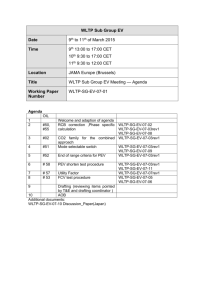

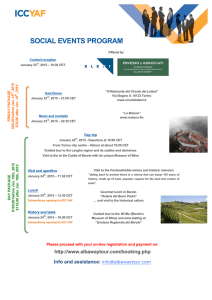
![[#BPIDEA-13] Give the option to show `View` count by unique views](http://s3.studylib.net/store/data/007700494_2-3911615de654a0135ad82f55710606d1-300x300.png)
